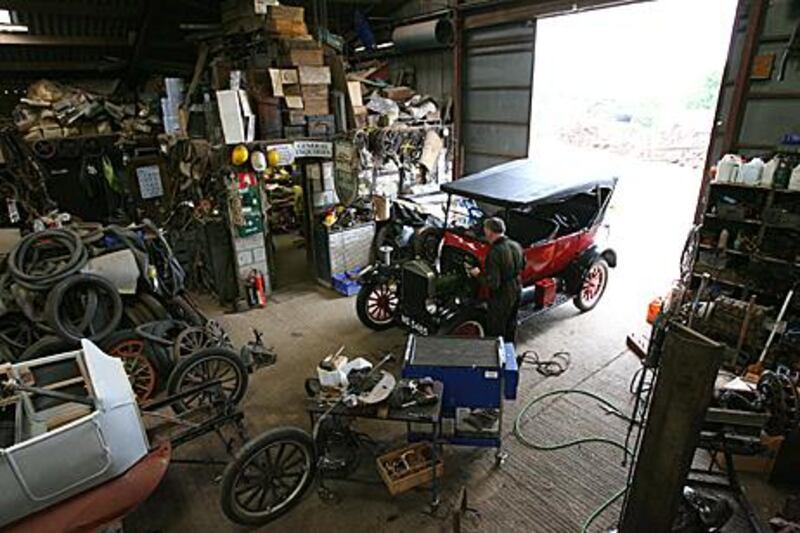In 1924, John Brazil, a butcher from the English county of Buckinghamshire, bought a van.
It was based on a Ford Model T, earnt its living until 1936, and was later put to work ferrying Home Guard reservists during the Second World War.
Brazil liked it so much that he still owned it in 1978, when he persuaded his great nephew Neil Tuckett to get it going again. Since Tuckett was an agricultural engineer, and the Model T is a deliberately agricultural piece of machinery, this proved straightforward, and the pair had a lot of fun entering the London-to-Brighton commercial vehicle rally.
"It was pretty obvious that the van was tired mechanically, so I restored it for him; and everything started from there," says Tuckett.
He eventually inherited the van, and would be the first to admit that it changed his life.
By 1981, Tuckett had bought another Model T and put it back on the road, and as his knowledge grew so did his reputation as someone who really understood these pioneering vehicles.
"It's a hobby that sort of got out of hand. You couldn't get parts easily. I'd find some, sell them and buy some more. Then I'd buy cars. Two became four, four became eight," says Tuckett, a softly spoken man in his fifties.
Tuckett's own homestead and the farm buildings he works out of in North Marston, England, are stuffed with parts and full Model T cars, ranging from a spindly racer to top hat saloons and incredibly aged, pram-like versions that look as if they belong in a Laurel and Hardy movie.
Henry Ford built 15 million of the things between 1908 and 1925, and although more Volkswagen Beetles, Golfs and Toyota Corollas have been made since, it's arguable that, Beetle aside, each generation of the models were actually different cars with the same name.
By contrast, Ford stuck with the Model T's basic design, mostly changing it to strip out cost, until eventually its antiquity began hurting sales. Before that happened examples had been built from England to Japan, its price had tumbled and it provided affordable motoring for the masses for the first time.
Its towering success explains why Neil Tuckett can earn a good living looking after a car designed more than a century ago.
The Model T's universal appeal remains today because it's still remarkably usable. When Ford celebrated the model's centenary by having some new Model Ts made, they roped in Tuckett, and next year he hopes to re-enact a period publicity stunt where a Model T was driven up Scotland's Ben Nevis mountain.
Over the years, Tuckett has acquired some cars with extraordinary back stories, including one example he calls Rusty, because it hasn't a hint of paint left on its body.
"It belonged to Sir Robert Fossett's circus [in England]," he says. The car was registered in 1928, was laid up four years later, having been "used by Fossett as a lead car to go where they were setting up [the circus]. I found it stored in a yard in Northampton, but I haven't restore it. Future generations should see some cars like this."
After nearly eight decades of inactivity, getting Rusty going again involved servicing the carburetor, clutch and back axle and replacing perished rubber hoses. Tuckett says it runs happily on its original spark plugs, which he's never removed.
Some of the cars that have passed through Tuckett's hands have found their way to the Middle East, including six that are now part of Sheikh Faisal bin Quassim Al Thani's vehicle collection in Qatar.
One of those was an extraordinary example that had been a museum exhibit in Colorado, where a friend of Tuckett's found it.
"It was a complete Hillbilly car. The owner had died in 1955 and it still had little bags of nuts on the side and his toolbox in the back. There was a pulley on the front to run a saw bench. The guy used the car to feed his cattle.
"I shipped it back to my friend's yard in the middle of Kansas and used it as my everyday car [when visiting]. I was in a place called Iola [about 650km from Colorado], parked up and a crowd gathered. One person asked where I'd got it, then said: 'That's Bradley's car.' He was the local carpenter.''
Tuckett still marvels at the coincidence of this car accidentally finding its way to its former home while in his hands, and initially offered it to the town.
Bradley's Ford arrived there in a container, but under the right circumstances, it would be easy to imagine Tuckett driving it from Colorado.
The Model T's durability was one reason for its success, helped in part by it being simple to make in the first place. Ford used this to his advantage when he introduced the assembly line and mass production in 1913, having seen something similar in Chicago meat factories.
The car was also perfectly engineered for a hostile environment, where there were few tarmac roads but a lot of dust, mud and extremes of weather, so it had a tough, slogging 2.9L engine, high ground clearance and suspension with a lot of travel.
Even today, a Model T will lope along at 60kph for hours, and is surprisingly comfortable.
The controls that make it go take some getting used to. There's a gear selection lever and three foot pedals, which engage the two forward gears and reverse. One makes the car stop - a process often helped by the handbrake. A lever on the steering column controls acceleration.
All this can bamboozle first-time drivers today, used to very different controls, but like the rest of the car there's a relentless logic to its controls and, according to Neil Tuckett, young children - the sort who teach their parents how to use computers easily take to it.
"If they haven't driven anything else, it makes perfect sense."






